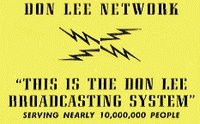 The Mutual Broadcasting System
The Mutual Broadcasting SystemIt begins in 1929 as the Quality Network, with four radio stations: WLS in Chicago, WOR in New York City, WLW in Cincinnati, and WXYZ in Detroit. The Quality Network operated for about 6 months only in 1929, and failed due to technical and funding problems. Some of those same problems would haunt Mutual for the next twenty years. [Do not confuse QN with WTAW's Texas Quality Network, these are totally unrelated. ] The network was really run by WGN in Chicago and WOR. It was a first attempt, and the second attempt would not come for another 5 years.
In September of 1934, the Mutual Broadcasting System was founded. They aspired to be the largest radio network in history, it was clearly a reaction to the rapid expansion of CBS, NBC and ABC. The other three networks of the day were funded, connected, and had already carved out a huge slice of the radio advertising market for themselves. There wasn't much left of the pie for Mutual. MBS usually trailed 3rd or 4th in number of listeners and in advertising revenue.
http://www.oldradio.com/archives/prog/mbs.htm
As great as it was to have the most stations, it's quality and not quantity that counts. Most of those 300 radio stations were small, low-power, local market radio stations. This economic fact limited their access to large advertisers. It kept them out of the big money.
For it's members the big plus was that Mutual was owned by its stations and not the other way around. But only a few of those stations were real powerhouses and thus called the shots WOR (New York), WGN (Chicago), and the West Coast collection of Don Lee stations held most of the controlling shares in the System. Mr. Lee was another kook of a buisnessman. Mr. Don Lee, He had exclusive distribution rights in California for Cadillac automobiles and seemingly on a lark entered the broadcasting business by purchasing station KFRC in San Francisco and KHJ in Los Angeles. Don Lee had originally affiliated his stations with CBS but he died in 1934 and the new management went with MBS. Don Lee quietly rolled over in his grave.
http://www.sfmuseum.org/hist5/donlee.html
 In the 1940s control of MBS moved away from the hundreds of smaller affiliates and into the control of a succession of large corporations: General Tire and Rubber, Armand Hammer, the Hal Roach Studios, and Albert G. McCarthy, Minnesota Mining and Manufacturing (3M)... even Amway even owned it at one point. More here.
In the 1940s control of MBS moved away from the hundreds of smaller affiliates and into the control of a succession of large corporations: General Tire and Rubber, Armand Hammer, the Hal Roach Studios, and Albert G. McCarthy, Minnesota Mining and Manufacturing (3M)... even Amway even owned it at one point. More here.The executors of Mr. Lee's estate tried to keep the company together, but finally decided to liquidate the broadcasting company and sold most of the stations, the west coast radio network, the 50% share of Mutual to General Tire and Rubber Company in 1952. It became General Teleradio, Inc. became a wholly-owned subsidiary of General Tire. More here.
General Teleradio was renamed RKO General in 1958 after the acquisition of RKO Radio Pictures from Howard Hughes in 1955 for $25 million. General Tire sold the film studio production facilities to Desilu Productions for $6 million in 1956. Mutual was then sold to Hal Roach Studios.

It was at this time that Alex Guterma, the president of Mutual struck a deal with the Dominican Republic. He got paid to ensure that the network would broadcast favorable propaganda for that the Dominican republic. Guterma was indicted and eventually did 3 years in prison for an unrelated SEC violation.
The network was floundering, and the bad publicity wasnt helping. It was quickly sold to John Mc Carthy, a Florida businessman who ran it thru bankruptcy proceedings. 3M bauiled them out. Then the devil hmiself opened his wallet... Amway bought the network on September 30, 1977. Then finally at long last a real media company got their hands on it, Westwood One. In 1985 Westwood one was bought by infinity which was in turn owned by Viacom, a subsidary of CBS Radio. they survived as a brand name until 1999 when even that was folded under CNN radio.




No comments:
Post a Comment